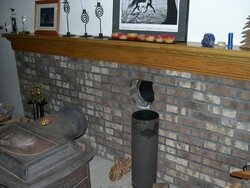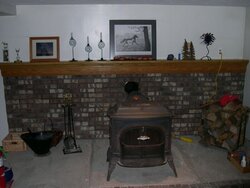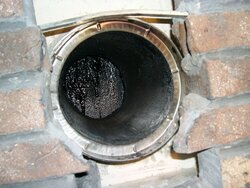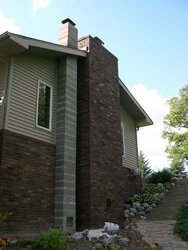Trying to work out whether I can do a much better job of minimizing creosote with my current setup. I need to do some repair/remodeling either way. Possible options I could consider include:
1. Simple repair of my current configuration.
2. Install of an oval liner, keep current stove.
3. Install of an oval liner, along with a new stove.
Current setup is a 1977 VC Vigilant, with an automatic damper on the intake air. Outlet is just an open or closed flue damper. Simple repair would be to make proper connection through the wall (straight back out of the stove into the flue). Liner is 7" x 12", and extends up a total of 23.5 feet.
I burn reasonably dry wood, as I get about 1/2 myself and buy about half in advance. I burn about 4 facecords a year for supplemental heat. Species vary, but include soft maple, cottonwood, and cherry in what I harvest, and unknown hardwoods in what I buy (denser than the cottonwood). I'd like to think I manage to season the wood for a year on average, though it may be a bit less (that's one area I know I need to work on).
Here's how I typically burn wood, which is where I'm hoping I can make the most improvements:
1. Set up some newspaper, along with some smaller wood pieces, some fatwood, or a wax-coated pinecone and 2-3 larger pieces of split wood.
2. Light the paper. I sometimes/often have smoke coming down the flue at the start, so I crack a nearby door and leave the stove doors open until draft is flowing right.
3. I close the doors on the stove when the fire is burning well, and my flue temperature thermometer is reading 100 F or more.
4. I run the stove with a flue temp reading of >200 to <500 F, based on the color coded zones on the thermometer. Have worked out the position on the automatic damper so that I don't need to mess with it.
5. Add wood as needed to maintain temperature. I generally don't touch the air intake when I do this.
A couple of photos attached that may help.
1. Simple repair of my current configuration.
2. Install of an oval liner, keep current stove.
3. Install of an oval liner, along with a new stove.
Current setup is a 1977 VC Vigilant, with an automatic damper on the intake air. Outlet is just an open or closed flue damper. Simple repair would be to make proper connection through the wall (straight back out of the stove into the flue). Liner is 7" x 12", and extends up a total of 23.5 feet.
I burn reasonably dry wood, as I get about 1/2 myself and buy about half in advance. I burn about 4 facecords a year for supplemental heat. Species vary, but include soft maple, cottonwood, and cherry in what I harvest, and unknown hardwoods in what I buy (denser than the cottonwood). I'd like to think I manage to season the wood for a year on average, though it may be a bit less (that's one area I know I need to work on).
Here's how I typically burn wood, which is where I'm hoping I can make the most improvements:
1. Set up some newspaper, along with some smaller wood pieces, some fatwood, or a wax-coated pinecone and 2-3 larger pieces of split wood.
2. Light the paper. I sometimes/often have smoke coming down the flue at the start, so I crack a nearby door and leave the stove doors open until draft is flowing right.
3. I close the doors on the stove when the fire is burning well, and my flue temperature thermometer is reading 100 F or more.
4. I run the stove with a flue temp reading of >200 to <500 F, based on the color coded zones on the thermometer. Have worked out the position on the automatic damper so that I don't need to mess with it.
5. Add wood as needed to maintain temperature. I generally don't touch the air intake when I do this.
A couple of photos attached that may help.






